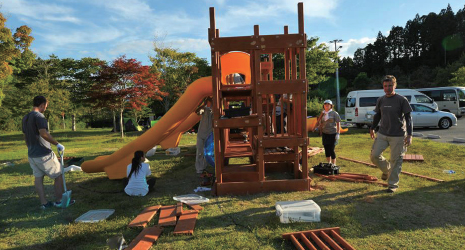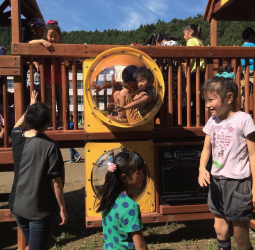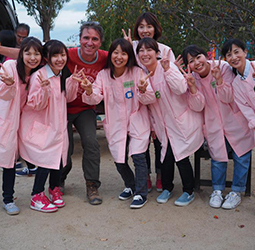Home > Highlighting JAPAN >Highlighting Japan March 2016>Five Years Down the Road to Reconstruction
Highlighting JAPAN


The Power of Play
Established a year after the Great East Japan Earthquake and tsunami, the NPO Playground of Hope is creating spaces and chances for children to play, knowing that play is crucial to their health and social development—and providing some healing for their communities in the process.
In the aftermath of the Great East Japan Earthquake and tsunami in March 2011, thousands were left homeless and inhabiting temporary housing units as they struggled to recover from the shock. Michael Anop, now the president of NPO Playground of Hope, first traveled to the Tohoku region in April 2011 as a volunteer to aid the people of Ishinomaki, Miyagi Prefecture. He continued to lend support by bringing food, water and other supplies to those sheltering in temporary housing in Minamisoma, Fukushima Prefecture.
Anop noticed that in addition to people losing their homes and businesses, schools and parks had been rendered unusable. “The people in Tohoku have a strong sense of community,” he observes. “After the disaster, everyone was focused on all the loss, but hearing the sounds of children laughing brought back a sense of hope. Playground of Hope started to work with local people to bring joy back into the community by reconstructing play spaces in parks, schools and local community centers.”
Five years since that fateful day, Playground of Hope has implemented thirty-nine projects in the battered Tohoku region, and has completed over fifty projects altogether counting those in other areas. The projects have created special connections between corporate sponsors and communities in need of play spaces. With volunteers from companies and communities collaborating, new play sets and other play equipment are popping up quickly.
Sumiko Takahashi, the principal of Komagamine Elementary School in Shinchimachi, Fukushima, was happy to see so many children coming to the school for the new play set constructed in the schoolyard in September 2015. “I think these projects are wonderful,” she says. “I was moved by how everyone had the same goal of wanting to see the children smile, and built a play set together in a short amount of time and also held an opening event. It was great to build the play set with people I’d just met, and to build a strong bond with them. I’m thinking about what kinds of volunteer activities I can start doing.”
Each building project is structured to allow up to a hundred volunteers to participate. Corporate partners become a part of the community, and the projects also educate and motivate their employees.
“We try to arrange a setting that offers a chance to work really hard, do something truly meaningful, and create a connection with a community that people know appreciates their hard work,” says Playground of Hope cofounder Neil Rosenblatt. “The companies are looking to show their commitment to communities and give their employees a chance to work together toward a common purpose. The setting, the activity, the interaction with the community and the continuing use of a new playground make that work.”
Through these projects, Playground of Hope is also addressing a growing problem in modern society—the lack of freeform outdoor play for children. Some of the reasons for this problem include the fact that children’s lives are full of organized activities such as cram school and sports, while they’re also spending more time indoors staring at the screens of televisions, computers and cell phones.
“There’s a growing mountain of research pointing to how essential play is in early childhood development,” Anop reports. “As parents and caregivers, we have to realize that play is not a luxury. It’s just as vital as getting your children to study. Playground of Hope is now working with communities to foster an awareness of the significance of play and to solve the growing ‘play deficit’ in their areas.”
To promote play, Playground of Hope will continue to build dynamic play spaces and participate in local events at parks and facilities across Japan. The NPO has also started to consult children about the design and planning of their play spaces. After all, who better to ask than the real experts?
© 2009 Cabinet Office, Government of Japan








